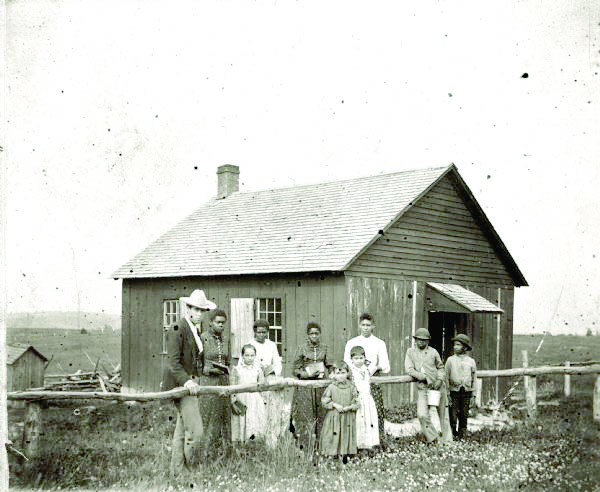The book I Have Walked One Mile After Dark in a Hard Rain by Sara Jo-Saebo for the Midwest History Project takes its title from a line in an October 9, 1850 letter written by one of the key characters in this narrative, Caroline Shepard, to a beloved family member.
Responding to a letter from her aunt who lives in faraway Virginia, Caroline says, “My Dear Aunt, I received your letter of September 21st exactly one week ago. I was so anxious to answer it that I have walked one mile after dark in a hard rain.”
The narrative is played out in three disparate counties, beginning in Fauquier County, Virginia; Grant County, Wisconsin; and Warren County, Mississippi, at Vicksburg.
The central focus is on the family of Charles and Caroline Shepard, who at the beginning of the story are newly liberated slaves brought to Grant County, Wisconsin, by a member of the slave-holding Horner family of Fauquier County, Virginia.
Charles Shepard and his wife, Caroline Shepard, along with his brother Willis Isaac Shepard were the property and presumed blood relatives of Sarah Fitzhugh Edmonds, their purported owner. Based on records cited by the Midwest Project, they should have been freed by the time of their arrival in Wisconsin, a slave-free territory, in 1848.
Three major points of history are chronicled in this small book as a backdrop for this short narrative of the family histories of one Black, the Shepards, and one white family, the Horners. Both families played a significant role in the Civil War, but their stories go well beyond that great national conflict that caused a major disruption, but not an end, to their stories.
THREE CONFLICTS
The Indian Removal Act of 1830 allows Euro-Americans in Illinois and the new territories of Iowa and Wisconsin to use whatever means they have at hand to force the Indigenous people from their lands. Even after the Native Peoples ceded over 50 million acres to the American government in 1804, that was not enough.
“Within twenty-four months of the new legislation, in the year 1832 – when Wisconsin and Iowa are still territories – the Indian Removal Act allows Euro-American people in Illinois to harass, persecute, and murder their Indigenous neighbors.”
The U.S. federal and state militias resorted to the massacre of the Osakiwug and Meskwaki people in the Wisconsin territory in 1832. Despite the sincere efforts of the great leader Black Sparrow Hawk, also called Black Hawk, to obtain peace and prevent the slaughter of his people, the new invaders of his land continue their plan to reduce the Red tribes to nothingness.
The Nat Turner Rebellion in Southampton, Virginia, was a second major cataclysm “that shook the foundations of the young United States.” This came as the distant population of Louisiana had nearly forgotten the great Black uprising of 1811, following the lead of Haiti, and the Denmark Vesey plan of revolt in Charleston in 1822.
The Civil War is the third and perhaps the most profound of the three disruptions that completely reshaped the world inhabited by the Horner and the Shepard families.
“The induction of a mature 45-year-old Charles Shepard into the United States Colored Troops in 1864 was soon followed by that of his 19-year-old son, John, who also sadly died at the end of the Civil War from a disease contracted during his deployment in the Vicksburg theater of war.”
MEN OF GREED
John Scott Horner was appointed Secretary of the Wisconsin Territory in 1836. Three years later, in 1839, several of his cousins and their siblings and offspring moved from Virginia and bought 8,000 acres in the Wisconsin Territory.
Some confusion may come about because of the unusual number of cousins named William Horner. The narrative lists four different William Horners across four generations, beginning with William Horner (1766-1841), the uncle of John Scott Horner. For the sake of clarity, we’ve designated the two most important as William Horner II (1793-1853), first cousin of the secretary; and William Horner III (1820-1873), the nephew and son-in-law of William Horner II. William Horner III, the son of Inman Horner (1791-1860), married his first cousin, Emily Horner, the daughter of William Horner II. For further clarity, Inman Horner was the brother of William II.
Shepard FAMILY
The Shepard family had already been manumitted before arriving in Grant County, Wisconsin from Virginia, a researcher of the Wisconsin Historical Society wrote in the 1970’s.
“In 1848, when his owner died and gave him his freedom, Virginia slave Charles Shepard and his family moved to Wisconsin,” the researcher says. “They came with William Horner, nephew of the former owner, who hoped to prosper at lead mining. Horner soon discovered that lead mining was on its last legs, but he liked Wisconsin so much that he bought nearly 3,000 acres of rolling farmland. Horner’s freed slaves (Charles and Caroline Shepard; their three children, Harriet, John, and Mary; along with Charles’ brother Isaac and his future wife, Sarah Brown) initially worked for him, but in only a few years the brothers Charles and Isaac had saved enough wages to purchase 200 acres and homesteads of their own. They called their community Pleasant Ridge.”
In the late 1850’s, William Horner III sold his Wisconsin property and moved back to Virginia to run his father’s plantation. He joined the Confederacy in 1861 and requested a “gentleman’s appointment” within the officer corps. He was appointed to the Commissary in Danville, VA and used his position to profiteer by selling agricultural products from his own plantation to the Confederate regiments.
Charles Shepard died at Vicksburg in August 1865, but he is not listed among the dead soldiers given stone markers in the Vicksburg National Cemetery. Nor is he included among the Wisconsin troops memorialized on the walls of the enormous Wisconsin State Memorial in the Vicksburg National Park.
Charles Shepard was assigned to Company K of the 50th Regiment of the United States Colored Troops (USCT) stationed at Vicksburg in the spring of 1864.
“Charles’ final resting place is unknown,” Sara Jo-Saebo writes. “But it is likely that he is buried in the African American section of the Vicksburg National Cemetery. Or maybe he’s in a mass grave established in crises in one of the city’s cemeteries.
“Charles’ name doesn’t appear in the rosters of the National Cemetery or on the bronze plates at the Wisconsin memorial,” she says.
The final words on the life of Charles Shepard are those of William M. Glenny, head of the Post Hospital at Vicksburg. In November 1865, Glenny registered his “Final Statement of Private Charles Shepard, 50th Regiment of US Colored Infantry, Volunteers. Died Aug. 26, 1865.”
And the last part of the Charles Shepard inventory: “Received this day, November, 1865 at Vicksburg, Miss of William M. Glenny 48th USC Inft., in charge, Post Hospital Vicksburg, Miss. ($10.00) ten dollars in treasury notes, the property of Charles Shepard late a private of Co. K. 50th USC Inftry. Who died at Vicksburg, Miss, Aug. 26th 1865. Signed JR Lofland.”
MILLIKEN’S BEND
The Jackson Advocate’s 2000 account of the Battle of Milliken’s Bend is given a considerable amount of discussion on pages 109-112 of this history. Raw and untested Black troops won the battle that took place on June 7, 1863 in the brier fields and wilderness on the Louisiana side of the Mississippi across from Vicksburg.
“The Black troops at Milliken’s Bend proved that even raw Black recruits could hold their own toe-to-toe with the best that the White South could throw at them. Somehow, that lesson has been lost to history,” the report says. “The bravery of the Blacks at Milliken’s Bend completely revolutionized the sentiment of the army with regard to the employment of Negro troops.”
When construction of the Vicksburg Military Park got underway in the early 1900’s with no mention of the role of over 20,000 Black troops from the Mississippi area and more than 200,000 in the total Civil War military, the Wisconsin delegation insisted that the 10 Black Regiments of the African Brigade and their heroic battle engagements should be given their proper place in the park displays and exhibits.
“Charles and John Shepard didn’t fight at Milliken’s Bend, but they were among the steadfast presence of Union garrison troops who arrived shortly afterward. They respond[ed] to the order to deploy to various skirmishes and battles and carry forth their duties in preserving the security of Vicksburg in between their long marches…. While their white counterparts are named on national monuments everywhere, members of the USC Colored Troops are not.”
When John Shepard musters out of service March 20, 1866 in Vicksburg, he catches a steamboat going north on the Mississippi and is looking forward to getting back home to Grant County, Wisconsin. Fate has its own way of determining outcomes, however.
The Dubuque Telegraph Herald reported: “John caught a fatal disease and died in Cairo, Illinois, on his way home to Pleasant Ridge.”
Like his father’s, John’s grave is probably marked by a simple headstone, “Unknown.”
UDC NOTES
In his move back to Wisconsin after the Civil War, William Horner sought to speculate in land sales but had a hard time meeting even his basic needs and had to find other employment.
Horner’s niece, Janet Horner, established the Virginia branch of the United Daughters of the Confederacy (UDC) in 1896. She lived well into the 20th Century and was one of the great purveyors of the Grand Old-South myth.
“Janet was a cornucopia of Southern charm,” in Richmond in 1924, says the author.
“Essentially, the UDC was devoted to broadcasting a narrative where enslaved Americans were, in fact, not the victims of slavery or that the goal of the Civil War was to even free these Americans. According to the UDC, the victims of the Civil War were the plantation owners.”
Janet died in 1927.
The last known relative of Charles and Caroline Shepard to live in Grant County, Wisconsin was Olive Green Lewis, who died in 1959.
I Have Walked One Mile After Dark in a Hard Rain is available at Barnes & Noble and at midwesthistoryproject.org.






